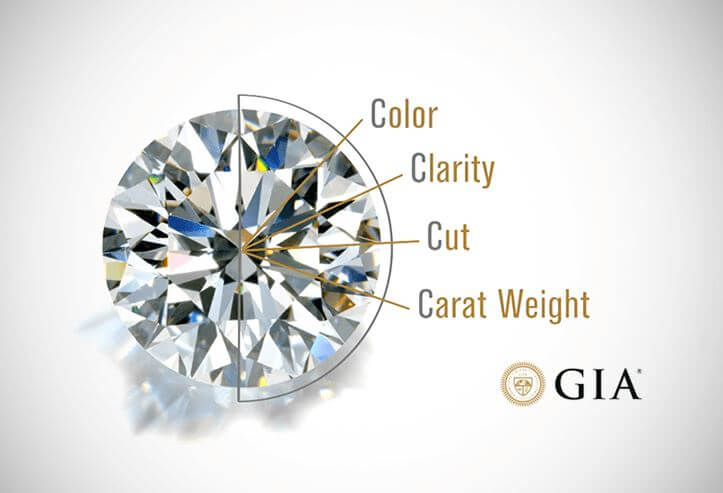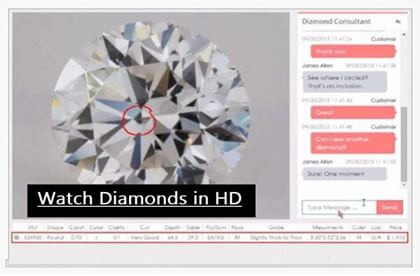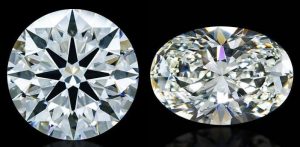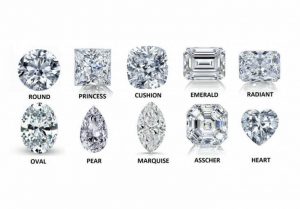Executive Summary
The 4Cs of a diamond are globally recognized and accepted a standard set by the GIA for judging and grading a diamond. The 4Cs are Cut, Color, Clarity, and Carat weight. These 4 parameters are the standards used by different grades and laboratories for grading diamonds. All 4 individually and collectively determine the value of a diamond.
The cut is the most important of the 4Cs and it takes priority during the grading, evaluating and pricing of a diamond. The beauty of a diamond depends majorly on the diamond’s cut. The 3 main aspects of cut that determines the diamond’s brilliance are the brilliance, fire, and scintillation of the diamond. A diamond with a poor cut would be that diamond that is dull without any fire, brilliance or scintillation. This is how important the diamond cut is. The grade for diamond cut ranges from Excellent to Poor cut.
The diamond color comes next after the diamond cut. The best diamonds are actually colorless diamonds but that does not erase the fact that there are diamonds with color. The presence or absence of color in a diamond and the extent of the color in a diamond is used to measure and estimate the value of the diamond. The color scale by the GIA runs from D-Z.
Diamond clarity is a measure of the degree of flaws and impurities found in a diamond. The clarity of a diamond is used to measure the value of a diamond based on the presence or absence in the physical appearance of the diamond. The clarity scale ranges from Flawless (FL) to included (I).
The carat weight of a diamond is the measure of the weight of the diamond. The carat weight of a diamond is also a measure of the value of the diamond. As the carat weight of a diamond increase, the price also increases.
The 4Cs of a diamond are globally recognized and accepted standard for judging and grading a diamond. This standard was set by the GIA during the twentieth century and since then has been the global standard for grading and describing diamonds.
The 4Cs are Cut, Color, Clarity, and Carat weight. These 4 parameters are the standards used by different grades and laboratories for grading diamonds. The value of a diamond is based mainly on these 4 parameters. They determine the value of the diamond and subsequently, its price in the market. The introduction of the 4Cs has made it easy for even the layman to understand the value and valuation of diamonds. So diamond buyers now know exactly what they want, what they are buying and what it’s worth.
Analyzing the 4Cs
All the different parameters that make up the 4Cs have their different characteristics and peculiarity and the different ways in which they affect the diamond. All 4 members of the 4Cs are important but there are different levels of importance.
The Cut
This is the most important of the 4Cs. When it comes to grading, evaluating and pricing a diamond, it takes the utmost priority. More than the others, the diamond’s cut affects the appearance and overall outlook of the diamond. The beauty of a diamond rest majorly on the cut of the diamond. The reason why diamonds are regarded as the most precious stone is because of its brilliance and sparkle, this is what brings out the beauty in a diamond, and it is dependent on the cut of the diamond. If you ever find a dull diamond, without any fire, brilliance or scintillation, there will be nothing to attract you to the diamond, it will not be any different from an ordinary stone without any value. That is to tell you how important the cut is to the diamond. A diamond with a poor cut would be that diamond that is dull without any fire, brilliance or scintillation.
The cut of the diamond affects 3 main aspects of the diamond. They are:
- Fire: This is the different spectacularly beautiful color that flashes all around the diamond. This contributes largely to the beauty of the diamond as we see it and is well seen in excellently cut diamonds.
- Brilliance: This is the ability of a diamond to create the brightness that we see around it by the combination of the white lights that the diamond reflects. The brightness that this combined white light produces around the diamond is what’s known as the brilliance of the diamond. A diamond’s brilliance depends a lot on how well cut the diamond is.
- Scintillation: The beautiful, alternating light and dark reflection on the diamond as it is moved is known as the scintillation of the diamond.
Different Grades of Diamond Cut
According to the GIA, there are different grades of diamond cut. The GIA invented a scale to show the different grades of a diamond cut. The scale runs from excellent cut to poor cut.
Excellent Cut: This grade of diamond cut is the best cut grade for diamonds. It is also referred to as the ideal cut or perfect cut. When a diamond has this type of cut, it always shows maximum fire, brilliance, and scintillation, making the diamond appear very beautiful. These diamonds also reflect all or almost all of the light that enters them leaving nothing or very little of the light to leak through the sides and under of the diamond. They also exhibit an even alternating pattern of light areas with dark areas in motion adding to the overall beauty of the diamond.
Very Good Cut: This is the second best cut grade and is very similar to the first cut grade. Diamonds with this cut grade reflect most of the light that enters into them. They also exhibit a splintery pattern due to their higher crown height and steeper crown angle. Very much like the excellent cut, they also exhibit a very high level of fire, brilliance, and sparkle. Although not as well as the excellent cut.
Good Cut: This cut is very much average in every sense of it. The diamonds are not usually as beautiful as you will expect a diamond to be. This is because of the steep pavilions which these diamonds have. They also have a low crown height and their crown angle is usually steep and shallow. These are why they are not able to reflect as much light like the above grades. They reflect a lot of the light that enters them but they also lose a lot of them too.
Fair Cut: This is obviously a below-average cut. Diamonds with this level of cut are not usually very beautiful. They lack the sufficiency of brilliance and fire needed for a diamond to appear beautiful. The reason is simple, these diamonds lack the ability to reflect most of the light that enters them. The light ends up exiting the diamonds through the bottom and side of the diamond rather than the top of the diamond where they would have been reflected. The crown angle and pavilion angle of these diamonds are very shallow and this generally gives the diamond a darker appearance than you would have expected from a diamond.
Poor Cut: This is the least of the cut grade and so you should not expect anything good from a diamond with this cut. These diamonds are very dull. They lack all the brilliance, fire and scintillation in diamonds. So they are not bright in any way and are consequently not beautiful. Very much unlike the other diamond cuts, they tend to lose all or almost all of the lights that come into them through the bottom and sides of the diamond. This implies that nothing or very little light is reflected from the top of the diamond (which is what makes a diamond brilliant). These diamonds look more like an ordinary stone than they look like a diamond because they lack the necessary spark and fie that diamonds possess.
The Color
This is another very important parameter for grading a diamond and estimating its value. After thoroughly considering the cut of the diamond, the next thing you want to look out for is the color of the diamond. The best diamonds are actually colorless diamonds but that does not erase the fact that there are diamonds with color. The presence or absence of color in a diamond and the extent of the color in a diamond is used to measure and estimate the value of the diamond.
The GIA created a color scale to evaluate and grade the extent of color in diamonds. The scale runs from the alphabet D – Z. The scale started from D and not A to avoid confusion with older diamond color scales than makes use of the letters A – C. There are subdivisions of the scale into colorless diamonds, near colorless diamonds, faint color diamonds, very light colored diamonds, and light-colored diamonds.
Diamond Color Scale
Colors in diamond impact the value of diamonds a lot. So this scale was made by the GIA to make it easier to grade diamonds. The ideal situation is for a diamond to be colorless and there are a lot of diamonds that appear colorless to the naked eye but in reality, they have colors in them. The real colorless diamonds are very rare in nature. So to make it fair for all, the scale was introduced to distinguish the colorless diamonds from the nearly colorless diamonds and other slightly colored to colored diamonds. This would prevent sellers from selling colorless diamonds at ridiculously low prices and buyers buying colored diamonds for ridiculously high prices.
Grade D – F (Colorless Diamonds): The first 3 classes of the color scale are grouped together as colorless diamonds. The difference between them is very slight and hardly noticeable, especially to an untrained person. But they do not have the yellow tint that characterizes other diamond color groups. Diamonds in this group are very rare in nature especially the grade D. They are also the grade that is the most sought after by buyers which make them very valuable and very expensive as well. Although the difference between them is hardly noticeable, the difference in price is quite much. The colorlessness of this group of diamonds means that they are able to fit into any diamond setting.
Grade G – J (Near Colorless Diamonds): Diamonds in this group are the closest to the colorless diamonds. For the most part, they also appear colorless to the naked eye. But they do have color in them, so they cannot be referred to an as colorless diamond. But the color in them is not so much to fully call them colored diamonds. The difference between two adjacent grades might not be noticeable but between the two extreme grades of the group G and J, the difference is very clear. That is why it makes more sense to subdivide the group into 2, the upper G and H and the lower I and J. The difference between them is clear even if they are both labeled near colorless diamonds by the GIA. They go well with different setting too. G – H goes well with palladium ring, white gold or platinum setting. H – J goes well with a yellow gold setting. You should try to avoid diamonds from grade J downwards.
Grade K – M (Faint Color Diamonds): The color in diamonds is usually a yellow tint and in this diamond color grade, unlike the earlier mentioned ones, the yellow tint is usually visible to the naked eye. The yellow tint can be faint but it is still noticeable to the eye. This color in them reduces their value and marketability. Demand for them is also not as high as the first two groups so the prices of these diamonds are not usually very high. Although the price is cheap and more affordable than the colorless and near-colorless diamond group, many jewelry stores do not usually have this group of a diamond. This is because of their color, coupled with the fact that people do not demand them for the same reason.
Grade N – R (Very Light Color Diamonds): The color in this group is very easy to notice. The color is usually a yellow or brown tint but it leaves the diamond undesirable. The price for these diamonds is usually very low. You should avoid these diamonds.
Grade S – Z (Light Color Diamond): This is the last group for the color grades. They have a very yellow coloration which should ordinarily deter buyers but surprisingly, they are in more demand than the immediate groups above them. This is because the yellow coloration makes people consider it as a “yellow stone”. Many people buy them as replacements for the light yellow and faint yellow diamonds but they are not fancy diamonds.
Diamond Clarity
Due to the fact that diamonds are formed deep down in the earth in high pressure and temperature region, there is a likelihood of them being included by materials in such region. These included materials end up being flaws in the diamond.
Diamond clarity is, therefore, a measure of the degree of flaws and impurities found in a diamond. The clarity of a diamond is used to measure the value of a diamond based on the presence or absence in the physical appearance of the diamond. The more impurity a diamond has on its surface or inside it, the lesser the value of the diamond and the less impurity it has in or on it, the higher the value.
There are different types of flaws that can be found in or on the surface of the diamond. They are crystals, pinpoint, needle, clouds, needle, feather, graining, twinning wisp, cavity, chip, polishing lines, scratch and bearding.
Diamond Clarity Scale
The diamond clarity scale provided by the GIA classifies diamonds based on the degree of inclusions in and on the diamonds. The diamond clarity scale runs from flawless (FL) – Included (I).
Flawless (FL): This is the highest clarity grade for diamonds. They are 100% pure and do not contain any impurities at all. They are very rare in nature with only 1% of diamonds being flawless.
Internally Flawless (IF): These diamonds do not have any inclusions in them but they have blemishes on their surface.
Very Very Slightly Included 1st Degree (VVS1): These diamonds have very very small inclusions in them that are very hard to spot even when you view them under microscope magnification. It takes professional training to spot inclusions in these diamonds and mostly it is just tiny pinpoints that are spotted.
Very Very Slightly Included 2nd Degree (VVS2): The major difference between VVS2 and VVS1 is the location of the flaw in them. The flaws inVVS2 is located in the top half of the diamond but those in VVS1 are located in the bottom half of the diamond.
Very Slightly Included 1st Degree (VS1): These diamonds have more inclusions in them than the VVS2 grade. The inclusions are larger in number but they are not necessarily bigger in size. These inclusions cannot be seen with the naked eye but they are very noticeable under the microscope.
Very Slightly Included 2nd Degree (VS2): Just like VS1, most times, the inclusions in these diamonds are not visible to the naked eye. Only in a few cases that they are visible to the naked eye and that is when the diamonds have a large size. The difference between VS2 and VS1 is the type, size, and location of the flaws in them.
Slightly Included 1st Degree (SI1): These diamonds have inclusions that are very easy to notice under a microscope but it is also possible too to see these inclusions with the eye, even if it is not likely.
Slightly Included 2nd Degree (SI2): These diamonds have inclusions that are more noticeable to the naked eye especially if the diamond cut is emerald or Asscher cut. You might need some aid to see them in other diamond cuts.
Included 1st Degree (I1): In this clarity grade, the flaws in the diamond are larger and very visible to the untrained eye. These flaws affect the durability and brilliance of the diamond. From this clarity grade, there are different kinds of flaws that can be found in the diamond. There are lower clarity grades than the I1. We also have the I2 and I3 but because of their extremely poor quality, they are not found for sale in jewelry stores.
Diamond Carat Weight
The carat weight of a diamond is the measure of the weight of the diamond. One metric carat is known to be 200mg. The carat weight of a diamond is also a measure of the value of the diamond. As the carat weight of a diamond increase, the price also increases. Larger diamonds have a naturally rare occurrence than diamonds of smaller sizes. They are so rare that not up to one in a million rough stones that are mined is large enough to get a finished diamond from them that weighs one carat. So with every increase in carat weight of diamonds, you will have to pay more, the payment is more of a price per carat basis. That is why with an increase in the weight of the diamond, the price of the diamond increases. This does not mean that 2 different diamonds with the same carat weight will have the same market value. The market value of diamonds depends not only on the carat weight of the diamond but also on the cut, color, and clarity of the diamond.
When considering the carat weight of diamonds, you must put into consideration the cut of the diamond. A diamond that has a high carat weight but a poor cut may appear smaller than it should normally be and they cut deeper than other diamonds that have better cut and smaller carat weight.
Buying Tips
- The diamond cut is the most important of all the 4Cs, so you should pay more attention to it when buying your diamond. As much as possible, make sure that you get a diamond with an excellent cut, if you fail to, you can settle for a very good cut. But try not to settle for lower than this.
- You can save money here by settling for the nearly colorless diamonds rather than buying the colorless diamonds. The idea is for you to not buy a diamond with a coloration visible to the naked eye. So settling for a diamond within the G – I grade will ensure that you have a diamond with no visible colors and you still keep some change.
- The clarity of the diamond is important, but it is also important that you save some money wherever possible. Except you are working with an unrestricted budget, you do not have to buy a flawless diamond or even an internally flawless diamond. The idea here also is to buy a diamond that does not have any impurities that are visible to the naked eye. While flawless and internally flawless meet this goal, they are very expensive and do not help you to save money. But going down the clarity scale, we also have the VVS 1, VVS2, VS1 and VS 2 grades which are also clear to the naked eye. Since the goal is to save money, it will be more ideal to go for the least of them which is VS 2.
- To save money on the carat weight of the diamond, it is best to buy shy. Buying shy means going a little bit lower than the whole. For instance, rather than buy diamonds with 1.0, 1.5, 2.0 and 2.5 carat weight, it is better to go 0.9, 1.4, 1.9 and 2.4 respectively. The difference of 0.1 in the carat weight is inconsequential to the size, weight or look of the diamond. Nobody would know that your diamond is short of that mark but the difference in the price of 0.9 and 1.0 is worth keeping.




